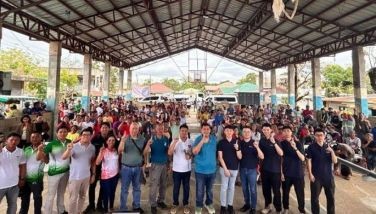Paulit-ulit

Our flooding problem needs to be fixed. We just spent the last week-and-a-half going all over Metro Manila and nearby provinces distributing relief goods. I really want to thank all the volunteers, government workers, medical professionals and frontliners who came to help their fellow Filipinos in need, despite being victims themselves. This is truly the spirit of bayanihan, but this isn’t sustainable. Our resilience is unparalleled but what we need are reforms.
Last year in August 2023, Super Typhoon Egay devastated the Philippines. Official government figures now indicate the damage to infrastructure, agriculture, fisheries, livestock, poultry and others at a staggering P15.318 billion, and 30 deaths. As if we completely forgot the lessons of barely a year ago, last month, right after the State of the Nation Address, Metro Manila was submerged and paralyzed. Super Typhoon Carina’s damage to Philippine agriculture is currently approximately P1.21 billion, and P4.09 billion to infrastructure. Worst, we lost the lives of 40 Filipinos.
Senator Joel Villanueva delivered a rousing speech last July 29 on our perennial unsolved flashflooding problem, and I could not help but agree. Last year with Typhoon Egay, he astutely contextualized our situation as a four decades-old problem. “Paulit-ulit!”
Senator Grace Poe filed Senate Resolution No. 1080 on July 29 for a “thorough inquiry into the utilization of the DPWH’s Flood Management Program” and for the DPWH to “explain the downward trend of its fund disbursement for flood control and management projects despite getting increases in budget in the last five years.” Senator Poe also noted that with the 2024 budget for flood management in the amount of P556 billion, DPWH had at minimum P1 billion per day to fix the problem. Yet just last week DPWH admitted that our “national flood control master plan” is barely 30 percent completed, 12 years since it was created in 2012.
Never mind the flood waters’ crippling effects on Metro Manila’s commercial and motorist traffic, because it also exacerbates indigent patients’ limited options in accessing affordable quality health care and exposes them to more expenses and even to painful yet completely preventable deaths. Members of my own team had difficulty getting medicine because the stocks were sold out in pharmacies across NCR.
Overwhelming flooding in Metro Manila and its neighboring areas isn’t novel. However, there are ways to stem the tide.
In the United Nations Educational, Scientific and Cultural Organization (UNESCO) 2023 publication entitled “Best practices on flood and drought risk management,” it determined four main best practices thereon, to wit: (1) hazard and risk maps; (2) early warning systems and real-time monitors; (3) payment schemes for disaster recovery and (4) bottom-up and participatory approaches.
To be fair, we are already doing some of the best practices available. It appears, however, that we are either not doing enough or there are missing key institutional mechanisms. Our foundations are not merely weak, but sorely lacking.
To mention some issues that must be addressed, we must consider that Metro Manila and similarly topographically vulnerable areas have no central flood control authority. A central flood control and management authority that systemically collaborates and coordinates with local units would mitigate time-consuming and trust-eroding jurisdictional disputes. Current intergovernmental collaboration efforts are reactive, ad hoc or temporary. Flood hazard maps are under-utilized. Sewerage systems, whether existing or under construction, are disjointed, inadequate, isolated and mismanaged. Ancient, protective and indispensable mangroves, with its rich flora and fauna, are destroyed. Sustainable river dredging and excavation projects are inconsistent.
In this regard, Senator Poe’s proposed “National Water Resource Management Act” or Senate Bill No. 102 filed last July 7, 2022 is a good starting point for lasting positively impactful reforms. Apart from creating a Department of Water Resources with sustainability in mind, it, inter alia, provides solutions for flood control and flood risk management. We remain hopeful since the Legislative-Executive Development Advisory Council (LEDAC) has tagged it as a top priority bill.
Our national land use law, also decades-in-the-making despite being critical foundational national legislation, remains an elusive enactment. The consequences of its delayed passage are immense and intergenerational. Without it, history has shown that there is simply, systemically, no incentive and no conducive common ground for a unified, efficient, comprehensive and cohesive national program across local government units (LGUs) traversed by river systems. Instead, localities upstream are free to formulate, adopt, implement and revamp decisions that are detrimental to localities downstream, and vice-versa. It infringes on overarching national priorities, and forces our communities to flounder among floodwaters. In this regard, passage of a National Land Use Act is required.
We must likewise recognize that collaboration with international partners is crucial. A great example is our partnership with Japan through the Japan International Cooperation Agency (JICA). The JICA-aided Pasig-Marikina River Channel Improvement Project, together with the similarly JICA-aided Manggahan Floodway, was credited for reducing economic losses by 80 percent in 2020 against Typhoon Ulysses. We have Japan to thank not only for our economic and military partnership, but also for flood control projects across the nation including Cavite, Cagayan de Oro and Davao.
Finally, solid waste management implementation problems became blockages in irrigation infrastructure and sewerage systems. President Marcos Jr. underscored in frustration that that trash had prevented irrigation pumps from working during the Super Typhoon Carina disaster.
The fact remains we have been needing a solution to our typhoon tragedies for close to half a century now. With climate change catastrophes and consequences closing in on us, our window for life-saving solutions is coming to a close. Always remember that “those who do not learn from history are doomed to repeat it.”
We need innovation in our public institutions and we need it now.
- Latest
- Trending

























